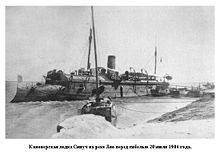9/30 inch M1877 cannon
| 9/30 inch M1877 cannon | |
|---|---|
| General Information | |
| Military designation: | 9 "/ 30 пушка обр.1877 г. |
| Manufacturer country: |
|
| Developer / Manufacturer: | Obukhov works |
| Development year: | 1883 |
| Start of production: | 1883 |
| Number of pieces: | 2 (3) |
| Weapon Category: | cannon |
| Technical specifications | |
| Pipe length: | 6.858 m |
| Caliber : |
229 mm |
| Number of trains : | 52 |
| Elevation range: | -5 to +11.5 degrees |
| Furnishing | |
| Closure Type : | prismatic wedge lock system Krupp |
| Charging principle: | Grenade and propellant bag |
The 9/30 inch cannon M1877 (Russian: 9 "/ 30 пушка обр.1877 г.) was a naval gun of the Imperial Russian Navy .
history
In 1883, Musselius proposed the development of a longer 9-inch cannon that would weigh around 18,500 kg and fire shells with a projectile weight of 48 kg. In the same year the Naval Office ordered two such weapons for the river gunboats of the Siberian Flotilla, and another was to be stored. The 9/35 inch M1877 cannon was developed almost at the same time .
construction
The length of the tube was 6147 mm, which corresponds to 30 calibers. The tube had 52 puffs with a depth of 1.52 mm. The weight of the weapon with breech was 18,948 kg, the breech alone weighed 606 kg.
The shell types originally developed for the 9-inch M1877 cannon were used . Three different types of bullets could be used. The grenade with a body made of ordinary cast iron weighed 113.4 kg, was 2.5 calibers in length and was filled with 5.02 kg of explosives. The grenade with a body made of chilled cast iron weighed 126.2 kg and was also 2.5 calibers in length. There were also grenades made of steel with a weight of 126.2 kg and a length of 2.7 calibers.
Black powder with a weight of 49.1 kg was initially used as the propellant charge, before a propellant charge made of brown powder with a weight of 53.2 kg was used. A muzzle velocity of 561 m / s was achieved with both types of propellant charge; with a barrel elevation of + 6 ° this resulted in a firing range of 4630 m. When the weight of the propellant charge was increased to 60.2 kg, the muzzle velocity was 597 m / s. With a tube elevation of + 6 ° it was possible to shoot 4908 m, with a tube elevation of + 11.2 ° 5556 m.
The weapon was only used on the gunboats Bobr and Siwutsch . The construction developed by Lieutenant General FW Pestitsch (Ф. В. Пестич), head of the artillery department of the Kronstadt war port , was used. In order to dampen the recoil of the cannon, the upper carriage ran on an inclined slide , similar to a Vavasseur slide. The recoil was dampened by the friction of the carriage on the slide, the inclination and the cables, which were typical for the time, with which the carriage was moored on the slide. The recoil was also absorbed by a friction damper connected to the rollers. The damper consisted of panes and plates connected to the mount and connected to the frame. Before the shot, the plates and discs were pressed together, which increased friction. After the shot had been fired and the weapon had run back on the slide, the damper was released and the mount could easily roll back into the firing position.
The first carriage was tested in 1884 and then scaffolded on the Siwutsch . The elevation range was between −5 ° and + 11.5 °, the lateral range at 72 °. The recommended speed was 72 ° / min. The maximum pipe return was 2170 mm. The platform was 5486 mm long and inclined at an angle of 4 °. The total weight of the mount without weapon was 12,842 kg.
Individual evidence
Web links
- Information about the gun (Russian)
